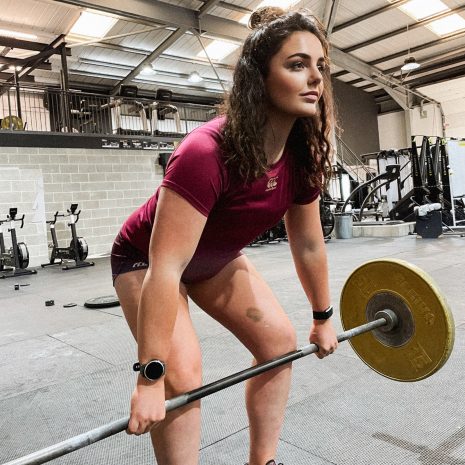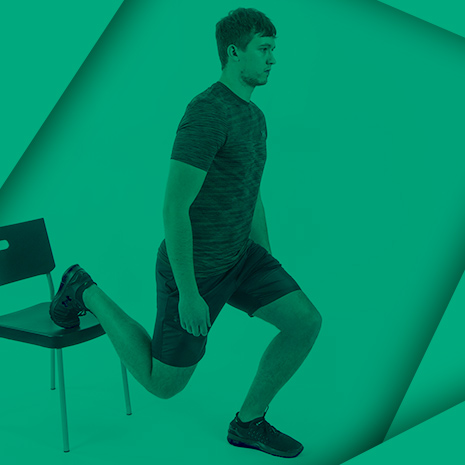The rugbystore team recently caught up with regular content contributor, Dean Robertson, who’s been busy competing in Powerlifting championships at the national level. We asked Dean about his training regimen leading up to the British Powerlifting Championships in October, and saw an opportunity to apply a variation of his strength training program to rugby.
NB: Before continuing, please keep in mind that although rugby and powerlifting require you to build strength, they are very different sports. This means that some elements of Dean’s powerlifting program’s ‘Taper Phase’ may transfer to rugby by improving strength, but they’re much more specific to the discipline of powerlifting. A tailored program for rugby should include more specificity to the sport, such as focusing on power work, sprints and agility.
I was lucky enough to be given the opportunity to compete in the British Powerlifting Championships earlier this month, after winning my weight class in the Perth Open and Scottish Champs earlier in the year. I felt this experience could also be adapted to these situations:
- Final part of rehabilitation
- Building strength and power
- Contribute to your pre-season training efforts

In this article, I go into detail on how I prepared for the British Powerlifting Championships. My aim is to give readers an extensive strength training program, adaptable to rugby players in the situations described above.
While not everyone needs to train for powerlifting championships, these activities should be part of a dynamic fitness routine within your rugby training program. Before you rush off to the gym, it’s important to remember that building strength is not simply about lifting weights. Nutrition and particularly recovery play very important roles in strength and power training – these are the variables that will condition your body and actually build muscle. If you’re in a rush, you can use the links below to skip to parts of the program that are of particular interest to you:
Taper training program
Nutrition
Recovery
Supplements
My British Powerlifting Championships Training Program
The training program consists of 5 days per week with 3 sessions consisting of squats, bench presses and deadlifts (different loads and variations each day) with 2 accessory days to facilitate recovery and technique. I’ve discussed proper technique for squats and deadlifts in the past, so make sure that your form is right in an effort to achieve desired results.

In order to nail the program’s preparation phase, I decided to consult a respected competitive powerlifter and great powerlifting coach, Mark Keys of Cast Iron Strength. Mark assisted me with the taper phase of the program, as it was an unknown area for me. The taper phase refers to reducing exercise in the days leading up to a competition in order to reduce the effects of fatigue on the body and specific muscles after intense training.
During this time, the intensity (weight) of each lift will continue to rise whilst the volume (sets/reps) falls over the last 3 weeks leading up to competition. This allows your body to recover more efficiently and to be in peak condition in time for a competition or major game.
I put my complete trust in Mark as a coach because of his extensive experience and belief in this technique. My advice is to trust the process and ensure your body heals as you go into the last week before the competition. The following is a breakdown of the three weeks leading up to the championships.
Please remember it is important to stretch and warm up before performing any weight session (I would recommend lifting 3 sets of a lighter weight as a sufficient warm up).
Taper – Week 1




As you can see from the program, the first week is pretty simple and basic. This becomes more specific to powerlifting and removes a lot of the variation of more offseason based programs. This allowed me to become more accustomed to the basic lifts of squat, deadlift and bench press. Doing all of the lifts on each day also better prepared me to do all 3 lifts on the day of competition – something that is very difficult if you don’t practice it regularly.
Taper – Week 2



From the program, you can see that week two is pretty much more of the same. I think people overestimate how much work they need to do to build real strength and end up overdoing it. Sessions are cut down to only 3 days during the second taper week, with deadlifting only 1 session (Day 1) to allow full recovery of the central nervous system.
Taper – Week 3


We cut down to only 2 sessions in the final week, with the last training session on Wednesday before competing on Saturday. You can also see that not only does the volume drop in this week, but the intensity reduces as well. The final taper week is more relaxed but still keeps your body familiar with the main lifts leading up to the competition (or the big game).
Nutrition for strength training
Nutrition is one of the most highly debated subjects in the fitness industry, with good reason. One thing I have discovered in the powerlifting world is that the reliance on nutrition seems to be less specific. The general gist is to make sure that you’re eating enough to recover and build muscle tissue – but to me, it’s more than that. I personally like to be a bit more mindful of both health and body composition, therefore I focus on my nutrition a little more seriously.
What’s right to eat, over/undereating, fasting, no carb, low carb, high carb – it simply isn’t necessary.
To keep things nice and simple, I set myself a few golden rules:
- Approximately 3000kcals on training days
- Approximately 2750kcals on non-training days
- Protein, carbohydrates and fats at each meal
- 5 meals per day
It really couldn’t get much easier than that. I genuinely believe people over-complicate their nutrition. Constantly questioning yourself; what’s right to eat, over/undereating, fasting, no carb, low carb, high carb – it simply isn’t necessary. I know from continual testing that the above meal plan works for me. My philosophy, as it is with many things, is to keep it simple and adjust when you see something not working.
Recovery
Training for a high-intensity sport like rugby is akin to racing a high-performance car. The harder you push the car, the more tuning and servicing it needs.
I’ve spoken about recovery before in more detail, as it’s one of the most important parts of training that tends to get overlooked. Body recovery and nutrition go hand in hand, so if you are not eating to recover, you will not allow your body the time to rest, repair, and build muscle tissue.
Massage
Sports massage is an essential component of recovery to ensure you are working out all the stress in your muscles. Training for a high-intensity sport like rugby is akin to racing a high-performance car. The harder you push the car, the more tuning and servicing it needs to make sure it performs at 100%.
If you do not stay on top of the servicing, the car will burn out and likely damage itself beyond repair. Deep tissue massage is not like your standard rub down – it hurts…a lot. By penetrating deep into the muscle tissue, the tension and stress built up in the muscles will be released. Find a good massage therapist that can do what you need done. I don’t recommend getting a cheap massage, as it’s one of those things where you get what you pay for!
Sauna, Steam Room, Jacuzzi, Swimming
While many may think of these as more of a “relaxation” part of fitness, I make sure that I frequent these activities often and tend to do them all in one session, for approximately 10 minutes each. It’s part of my recovery session that I fit in 4-5 days a week, usually first thing in the morning at 6am before I start the day. Swimming is a great way to kick off your morning, and it loosens your hips and shoulders which can develop tightness from lifting heavy weights during the day.
Sleep
It’s not the quantity of sleep that’s most important, but the quality
While the need for sleep does vary from person to person, in the end, it’s not the quantity of the sleep that’s most important, but the quality – the recommendation tends to be about 8 hours a night. If you’re getting that much sleep and still walking about like a zombie during the day, it might be worth looking into the quality of your sleep and adjusting your routine to guarantee a more beneficial, deep snooze.
Remember that the bright screens from mobile phones and computers, excess caffeine, and noise can all affect the quality of our sleep, so making sure to “switch off” as part of your nighttime routine could have beneficial effects on the quality of your sleep.
Programming
Following a program and having full faith in it will keep you consistent, accountable and take the guesswork out of your training. Not only will you see greater progress faster, you will know what works and what does not. It’s also suggested that you find a coach that is knowledgeable, experienced and can develop a program that suits you.
I have done my own programming up until now which has worked really well. As you move to higher levels of competition, it could be beneficial to call upon a professional in order to continue your progression.

Supplements
In order to ensure my recovery is 100%, I give my body what it needs. Sure, my nutrition provides essential vitamins and minerals necessary for recovery. But I know for sure that, if it were not for due diligence with my recovery strategies, I would have burnt out by now. I believe that the right supplements balanced with all other recovery techniques complete the full fitness regimen.
High-quality supplements = high-quality results
It’s important to do your homework, though, which is why I started looking into core nutritionals. Core nutritionals consist of a few supplements I take on a daily basis including a mineral solution, high-quality omegas, a high dose multivitamin, and my favourite – probiotics. I’ve taken supplements for years with very little effect, but after looking into the science of supplementation, I’ve learned what you need to do to make these additions work for you.
There are thousands of supplements out there and doing a bit of research into what will work for you – and what your body actually needs – will help you make better-informed decisions. It’s also vital to remember that high-quality supplements = high-quality results. The supplements I take on a daily basis have increased my energy levels and transformed the way I look at my overall health. I credit this to have been the secret weapon to improving my strength levels consistently over the past few years.
You’re ready to go
You’re now equipped with insight into the taper training, recovery and nutrition needed to help your strength and power stand out on the rugby field. Always remember that while the same program may not work for everyone, it’s still important to follow guidelines to encourage success and make sure you have a coach who understands your needs as an athlete. If you have any questions about my preparation, then please do not hesitate to contact me using the details below, or leave a comment.
Author’s contact details
Facebook – Elysium Training Systems | Instagram – @elysiumtrainingsystems | Twitter – @elysiumstrong | Snapchat – @elysiumgym | email – elysiumpt@outlook.com | phone – 07584123213





Comments